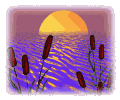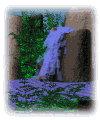 A lake is body of freshwater with three zones:
A lake is body of freshwater with three zones:
Lakes
 A lake is body of freshwater with three zones:
A lake is body of freshwater with three zones:
In temperate regions, lakes undergo changes in density and temperature. In winter, ice (less dense) forms on the surface over water that is warmer, much of it at 4 C (greatest density), and heavier. During the spring overturn, warming and winds cause oxygen to be carried downward and nutrients to the surface. By midsummer a thermocline between the upper warmer layers and lower cooler layers prevents vertical warming. During autumn, the upper layers cool and sink causing a fall overturn.
Interactions of soils, basin shape, and climate produce a continuum of trophic structure. Oligotrophic lakes are deep, nutrient-poor, and low in primary productivity. Eutrophic lakes are shallow and nutrient-rich often due to agricultural and urban runoff wastes.
Streams (Audio - Not Important)
Streams start out as freshwater springs or seeps. Three kinds of habitats form along a continuum from head waters to river's end:
 Several factors affect streams:
Several factors affect streams:
Phytoplankton are the beginning of ocean food webs. Their organic remains and wastes enter the detrital webs. As much as seventy percent of the productivity may be from microscopic ultraplankton.
In hydrothermal vents which are the fissures between the earth's crustal plates, water becomes heated and laden with minerals as it escapes. Elaborate food webs are supported at these sites.
Mangroves are forests in sheltered regions along tropical coasts. Ocean waves do not reach these saltwater ecosystems, so anaerobic sediments and mud accumulate. Salt-tolerant plants with prop roots dominate.
Estuaries are partially enclosed regions where fresh and salt water meet. Estuaries are incredibly productive feeding and breeding grounds for many animals. Many marine estuaries are under assault from raw sewage, agricultural runoff, industrial wastes, and too much freshwater.
The intertidal-zone inhabitants of rocky and sandy coastlines are alternately exposed and submerged. Existence is difficult. Rocky shores have three vertically arranged zones:
This animation (Audio - Important) describes the ocean zones.
If it's between 7am and 7pm PST when you're reading this, you can take a quick trip to the Monterey
Bay Aquarium and watch the
surf cam.
The height of the rocks above sea level will vary as the tides vary.
PREVIOUS
NEXT
LECTURE 15 INDEX
MAIN INDEX